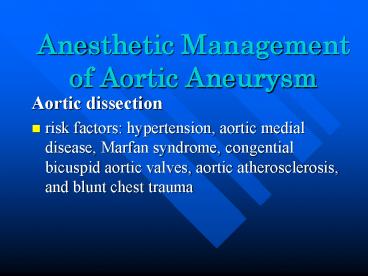Anesthetic Management of Aortic Aneurysm PowerPoint PPT Presentation
1 / 23
Title: Anesthetic Management of Aortic Aneurysm
1
Anesthetic Management of Aortic Aneurysm
- Aortic dissection
- risk factors hypertension, aortic medial
disease, Marfan syndrome, congential bicuspid
aortic valves, aortic atherosclerosis, and blunt
chest trauma
2
- Aortic aneurysm
- classified by etiology, location, and shape
- most common dissecion
- predisposing atherosclerosis, aortitis, cystic
medial necrosis, syphilitc aortitis, trauma,
postoperative false aneurysm, connective tissue
disorders, and congenital aortic anomalies - De Bakey and Stanford classification
- Shape fusiform and saccular
3
- Goal
- type and location of the lesion. one lung
ventilation and distal perfusion - prepare for blood loss
- monitor
- hemodynamic stability
4
- Evaluation
- medial history, pevious chest X-ray,
echocardiographic and angiographic stuides - prior lung status
- control of BP and ejection velocity combine beta
blockers and vasodilators
5
- Premeditation
- Elective beta blockers, calcium channel
blockers, diuretics, ACEI - anxiolytic agent (sedative) lorazepam 1-2mg PO,
midazolam 1-4mg iv and morphine 0.05-0.1mg/kg im - Emergency
- beta-blocking agents esmolol, metoprolol, or
propranolo - vasodilators nitroprusside, nitroglycerin,
trimethaphan
6
- Preinduction
- big iv cathether
- A-line
- femeral a-line
- pressor and vasodilator agents
- 6 units blood
- antithrombolytic agent (aminocaproic acid or
aprotinin) - epidural catheters
7
- Induction
- non-emergent procedure
- fentanyl (50-100ug/kg) or sufentanyl (10-12
ug/kg) - intermediate-acting, non-depolarizing
neuromuscular blocker vecuronium (0.1mg/kg),
rocurinium(0.6mg/kg), or cis-atracurium
(0.2mg/kg) - no pancuronium
8
- Emergent procedure
- rapid sequence induction
- thiopental , propofol,or etomidate in combination
with small dose narcotics - SCC, beta-blocker and vasodilator before
laryngoscopy - --single , double lumen, univent
9
- Intra-operative management
- additional venous access
- V5 lead, a-line, PA catheter
- bleeding and coagulopathy
10
- PWCP increase with cross-clamp application
- A. LV afterload mismatch with LV dilation
- B. myocardial ischemia
- C.impaired LV diastolic function due to impaired
relaxtion
11
- Acidosis
- sod. bicarbonate continuous infusion
(0.05mEq/kg/min)during cross-clamping
12
- cross clamp removal hypotension , pulmonary
hypertension, and metabolic acidosis - shunt and left heart bypass, partial CPB
- (distal 40-60mmhg)
13
- Acid-base status,
- renal functuin,
- short cross-clamp time
14
Awake Aortic Aneurysm Repair in Patients with
Severe Pulmonary Disease
- McGregor Am J Surg, Volume
178(2).August 1999.121-124 - BACKGROUND We report the use of retroperitoneal
aortic aneurysm repair utilizing exclusive
regional anesthesia (no intubation or inhalation
anesthetic) in high pulmonary risk patients.
15
- METHODS Six patients were retrospectively
reviewed. Pulmonary disease was diagnosed by
clinical history and pulmonary function tests.
Patients received intravenous sedation and
regional anesthesia. Retroperitoneal aortoiliac
aneurysm repair was performed.
16
- Regional Anesthesia.
- Patients upright, exaggerated kyphotic position
17-gauge epidural needle L2-3 or L3-4 interspace,
- test dose 3cc lidocaine 1.5 and epinephrine
1200,000 - A 25-gauge Whitticre needle Spinal anesthesia
with bupivicaine 0.5 (6 to 7 mg) and fentanyl
(25 to 30 mcg), - epidural catheter 3 to 4 cm. A T7-8 sensory
block was required to start the procedure - Inadequate bupivicaine 0.5 (10 cc) and fentanyl
50 to 100 mcg in incremental doses. - During aortic dissection and cross-clamping,
anesthesia was raised to the T5 level. - morphine (3 to 4 mg) for postoperative pain
control.
17
- RESULTS a population with several comorbidities.
Patient age was 72 /- 4 years, and concurrent
illnesses included coronary artery disease,
cerebrovascular disease, and obesity. Cardiac
ejection fraction was 46 /- 11. Smoking
history was 62 /- 2 pack-years. All patients
used inhaled steroids and albuterol, and 3
required theophylline and home oxygen - therapy.
- PFT severe pulmonary disease
- FEV1 0.85 /- 0.1 L (23 /- 5 of predicted),
FVC 1.64 /- 0.2 L (34 /- 5 of - predicted), and PO2 62 /- 2 mm Hg.
18
(No Transcript)
19
- The authors felt that the more recent use of
supplemental epidural anesthesia was partially
responsible for improved outcome. Epidural
anesthesia offers many benefits, including
inhibition of the surgical stress response,
decrease in myocardial oxygen demand, fewer
pulmonary complications, improved renal cortical
blood flow, and better postoperative pain
control.
20
- The improvement in pulmonary status is related to
a smaller decrease in FVC and FEV1, less alveolar
shunting, and fewer pulmonary infections. - Adverse effects of general anesthesia such as
myocardial and respiratory depression - pulmonary function values of less than 50 of
predicted are a relative contraindication to
elective aortic reconstruction. However, because
of the limited pulmonary sequelae seen using
retroperitoneal repair with exclusive epidural
anesthesia, patients with severely compromised
pulmonary function may be able to undergo
elective surgery.
21
- Several aspects of this study merit further
discussion. - First, both spinal and epidural anesthesia were
utilized better muscle relaxation and lower total
doses of anesthetic and narcotic medications are
needed. - Second, inhalation anesthetic was avoided by
maintaining patients at ideal level of
sedation.kept alert enough to protect their
airways and answer questions, but sedated enough
to control anxiety and agitation.
22
- Third, thorough communication among surgeon,
anesthesiologist, and patient is critical.
Reassuring patients on their progress and keeping
a calm operating room environment facilitates
patient tolerance and success with this
procedure. - Finally, this is a technically demanding
procedure with anatomic limitations that need to
be considered during patient selection. These
include limited access to the right renal artery,
inability to detect synchronous intraperitoneal
pathology, and long-term wound complications. - Performing this procedure on patients more likely
to be receiving systemic steroid therapy may
particularly predispose to wound complications.
Therefore, strict adherence to sterile technique
and careful tissue handling are essential.
23
- CONCLUSIONS
- Results from this study suggest that patients
with severe pulmonary disease can undergo
elective abdominal aortic aneurysm repair under
exclusive regional anesthesia safely and without
pulmonary morbidity. Patient selection, and
experienced anesthesiologist, and communication
with the patient are critical to the success of
this procedure. Retroperitoneal aortic repair
with exclusive regional anesthesia should be
considered in high pulmonary risk patients.

